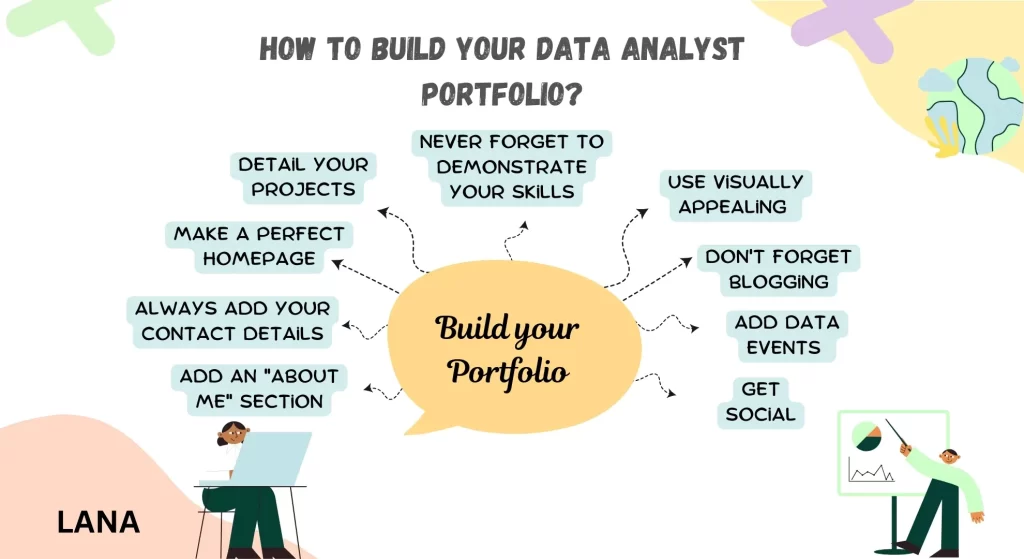How to Build a Data Analytics Portfolio and Get Hired [Success Tips]
- -
- Time -

In the ever-changing field of data analytics, a strong portfolio is your ticket to success. This post provides crucial success advice on how to build a data analytics portfolio that will not only highlight your abilities but also increase your chances of landing your dream job.
From tactical project selection to impactful presentation tactics, set off on a journey to improve your professional profile and establish yourself as a sought-after talent in the cutthroat world of data analytics.
Table of Contents
What is a Data Analytics Portfolio?
Your data analytics portfolio is a website telling potential employers everything about you with links to the different projects you may have completed. Hence, the first step is deciding where to create this portfolio. You can create it from scratch, where you will be responsible for customizing and making it per your needs. Or you can opt for pre-built templates on WordPress, Squarespace, and Wix.
In this portfolio, you can include projects you may have done during your certification course, such as the Data Analytics & Engineering bootcamp training from CCSLA and volunteering or freelancing projects.
These projects will help demonstrate some of the below-mentioned skills:
- Data scraping from different sources
- Cleaning up raw data
- Visualizing your findings
- Showcasing actionable insights
Use of Data Analytics Portfolio
To start your career as a data analyst, you must know how to build a data analytics portfolio. Your portfolio will be the essential aspect of your application. It will showcase and validate your data analytics skills to hiring managers, recruiters, and potential clients, which a resume alone cannot do. Your portfolio should be created so you can outshine other candidates easily, even if you are a fresher with no work experience.

Why Do You Need a Portfolio?
Can you imagine hiring someone without looking at their work? Similarly, companies only hire a data analyst after looking at their achievements. Every analyst will have skills, software, and projects to showcase. However, nobody knows whether you know them or not if they are on a resume. The problem comes when the hiring manager has to compare two candidates, both calling themselves perfect.

Even though there is always an option for technical assessment, it is feasible only if the number is less. Therefore, you must have a portfolio to tell what you can do as an analyst. It is also an easy way for hiring people to compare projects done by two candidates. However, it is about building a perfect portfolio that makes you stand out.
Therefore, you should know how to build a data analytics portfolio that can get you hired.
Choosing the Portfolio Platform
As mentioned before, the first step is deciding the platform where you wish to publish your portfolio. Besides the ones mentioned above, there are many free places to use. Let’s understand about them.
1. LinkedIn
It is very easy to use LinkedIn to add, update, and remove projects in your profile, which can also work as your portfolio. You can upload formats like PDF, .jpeg, Word, PowerPoint, and others to share your content.
Besides, there are different sections to add these projects, like experience, featured, and education.
2. GitHub
It is an open-source community of over 56 million developers and a perfect place to showcase your portfolio for free. You must create an account to add projects to the public repository. Here, you can easily showcase various elements, such as Jupyter Notebook codes.
You can add the GitHub link to your LinkedIn profile, personal website, or resume to attract potential recruiters.
3. Kaggle
Kaggle is a cloud environment platform from Jupyter Notebooks that can also be customized. Here, you can show off any data sets you’ve created or code you’ve developed and the outcomes of any Kaggle data science challenges in which you’ve participated.
You can opt for your website once you have enough experience and more data to add to your portfolio. You can use services from Wix or Squarespace that offer pre-built templates and create a portfolio. You can also use WordPress if you are comfortable with HTML.
Elements of a Solid Data Analytics Portfolio
Listed below are the main things you must add to your portfolio, regardless of being fresher or experienced:
- Basic personal information, such as name, contact details, LinkedIn profile, etc. It will be easier for people to contact you.
- A small yet crisp career summary indicating your experience and portfolio takeaways.
- A detailed section of your data analytics projects.
- If possible, links to your professional projects.
- A section about references of people who can vouch for your work.
Let’s look at how to build a data analytics portfolio in detail in the below section.
How to Build a Data Analytics Portfolio?
You can follow the below steps to create a compelling portfolio that can land you the perfect data analyst job.
1. Identifying Your Best Sample Work
When creating a portfolio, the first thing to do is determine your best work. In doing so, ensure that you maintain diversity by adding different types of projects. Additionally, remember to keep your content crisp yet engaging.
Since the person going through the portfolio will have a limited amount of time, it is essential to include only must-know information. Moreover, the layout of your projects should be so that every piece of information is readily available to the viewer.
2. Be True and Honest with Your Passion
You do not have to use the most complex models or tools for your portfolio. Instead, your portfolio should depict your true passion for your work. People will notice if you’ve scraped a dataset for a particular assignment, penned an engaging narrative, or produced something that shares your passion with the world.
If you can depict your passion, the hiring manager will be convinced you are the right fit for the role and company. However, remember these projects are not always easy to finish. Therefore, ensure you are 100% committed when choosing the best work to be part of your portfolio.
3. Add an Element of Storytelling
Your portfolios will be a representation of what you know about data analytics. Therefore, you must weave a storyline to attract and impress your audience. It would help if you told them what you can do. Next, you should demonstrate projects highlighting those skills while giving hints about your interests.
When you brilliantly combine your statements with supporting projects, you offer an excellent storytelling experience that your viewers will enjoy. Your projects should showcase why data analytics is needed to change the world’s situation in a story format.
4. Highlight Your Skills
The main reason for creating this portfolio is to highlight your skills, keeping your end users in mind.
Your portfolio should be able to highlight the below-mentioned skills for you:
- Technical proficiency
- Data analytics passion
- Strategic thinking
- Business acumen
- Communication skills
These are the skills that every company is looking for in their next data analyst, and it is a lot to accomplish. Therefore, you should know how to communicate these skills effectively, and if you cannot do so, do not push it. Just highlight what you have and can do effortlessly. Otherwise, it can backfire on you.
5. Always Add a Homepage
Remember to add a homepage to your portfolio if you want to make a good impression. It is the first thing everyone will see and a perfect place to make a lasting impression. However, the key is to keep everything crisp, which can be seen by telling them about yourself at a glance.
Including your picture with a high-impact personal statement and a summary of your professional experience is a good option.
6. Go for a Multimedia Portfolio
Using multimedia to showcase your interests is an excellent way of presenting a portfolio. Instead of mentioning the list of projects, use different methods for demonstrating purposes. You can use podcasts, humor, videos, and articles to tell everything about yourself and your work. Additionally, use bold visuals to attract visitors to your profile.
It is a way through which, instead of mentioning specific projects, you describe your entire timeline of data analytics using interesting methods. It can be pretty risky; however, if executed well, it can pay off.
7. Clear Demonstration of Technical Skills
If you want to create a job-winning portfolio, you must showcase technical skills; that is what the hiring managers are looking for. However, it does not mean you should know every skill. For instance, if you have spent hours using advanced scraping tools, you don’t have to put extra effort into using more advanced state-of-the-art tools to impress your audience.
The best approach will be to focus on one skill at a time, and your project should revolve around the same. Too many skills in one can end up making the viewer confused and also spoiling your project. Limiting your project’s scope is an excellent way of telling a story and demonstrating your technical expertise.
Besides, you should also ensure your codes are all well-documented and readable. Verify that notebooks have headings and descriptions. Review your code and annotate functions. A careful reader of a notebook will notice comments and well-defined variable names.
8. Adding Variety
Nobody likes to see a portfolio with similar kinds of work; variety shows how diverse your skills are.
Some projects that you should try and include are:
- Scraping data from websites
- Cleaning data
- Performing various kinds of analysis using data
- Storytelling using visualization
- Communicating a complex idea through data
- Group project showcasing collaboration skills
- Data analytics tool usage, such as Python, SQL, R, and Tableau
Try including as many as possible to give your potential hiring managers a chance to witness all your skills at once.
9. Optional – Adding a Blog
Even though it is optional and not a mandate, it can increase your chances. These days, many data scientists or analysts are adding blogs to their portfolios. It may look very odd; however, it can be a real value adder.
The ability to communicate complicated ideas in a clear, succinct, and understandable manner is a critical quality that hiring managers search for, and you can showcase this ability through your blog post.
If you are a fresher, write short articles explaining a topic or a feature. It will showcase your communication skills and also your passion for data science and becoming a data analyst.
Different Skills to Demonstrate in Your Data Analytics Portfolio
When discussing building a data analytics portfolio, a lot is spoken about adding skills. It is not just about adding any skill; adding the right skill can get you hired. As a data analyst, you will be required to use critical information to deliver insights that will be used for business decisions.

Therefore, it is not only about technical skills; you need to showcase your soft skills, such as interpersonal and communication skills. Besides, it would help if you were also well-versed in mathematics, statistics, analysis, and data visualization skills. Your portfolio should have projects that showcase such skills and make hiring you easier for the viewer.
Final Thoughts
When you finish this portfolio-refinement journey with success strategies specific to the data analytics industry, picture doors open up to lucrative career chances. Keep in mind that your portfolio is your story of competence, not merely a compilation of work. Now that you have powerful insights and a persuasive presentation, you are ready to take the job market by storm with a data analytics portfolio that speaks for itself and advances your professional objectives.
However, before that, irrespective of whether you are a beginner or an experienced person, you should brush up your skills by enrolling in a certification course. You can opt for a Data Analytics Bootcamp by CCSLA, a perfect place to begin your data analyst journey. In just 12 weeks, you can equip yourself with all the skills needed to showcase in your portfolio and get hired as a data analyst.
FAQs
A data analytics portfolio is crucial because it provides tangible evidence of your skills and abilities to potential employers. It showcases your proficiency in data analysis, your ability to solve problems, and your capacity to derive insights from data, making you a more attractive candidate for data analytics roles.
Your portfolio should include a variety of projects that demonstrate your skills in data cleaning, analysis, visualization, and interpretation. Include projects with a clear description of the problem, your approach, the tools and techniques used, and the insights or solutions derived. Also, consider incorporating case studies, code snippets, and interactive visualizations.
Start by working on personal projects or participating in online competitions like Kaggle. You can also contribute to open-source projects or analyze publicly available datasets to create case studies or insightful analyses. Document your process and findings to include in your portfolio.
Showcase your proficiency with popular data analytics tools and technologies such as Python or R for data manipulation and analysis, SQL for database queries, and visualization tools like Tableau or Power BI. Highlighting your ability to use these tools to extract insights and solve problems is key.
For each project, provide a brief overview of the problem or question addressed, the data source, the analysis performed, and the conclusions or recommendations made. Include visualizations to illustrate your findings and, if possible, links to interactive dashboards or GitHub repositories with your code.
Yes, including relevant courses and certifications can add value to your portfolio, especially if they’re from recognized institutions or platforms. They demonstrate your commitment to learning and keeping your skills up to date. Briefly mention how these courses have contributed to your projects or skill set.
Regularly update your portfolio to reflect your latest skills and projects. Adding new projects every few months or whenever you complete a significant piece of work will keep your portfolio fresh and demonstrate your ongoing commitment to developing your data analytics capabilities.
To make your portfolio stand out, focus on the quality and diversity of your projects, incorporate interactive elements or dashboards, and ensure your portfolio is well-organized and professionally presented. Personalizing your portfolio to reflect your unique skills and interests can also help you stand out.
Consider hosting your portfolio on a personal website, GitHub, or a professional networking site like LinkedIn. Choose a platform that allows you to showcase your work effectively and can be easily accessed by potential employers.
Include a link to your portfolio in your resume, cover letter, and LinkedIn profile. During interviews, refer to specific projects in your portfolio to demonstrate your problem-solving process and how you’ve applied data analytics skills to real-world situations.






